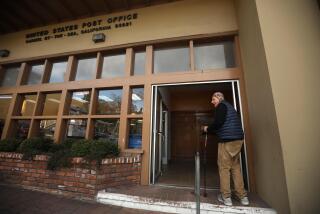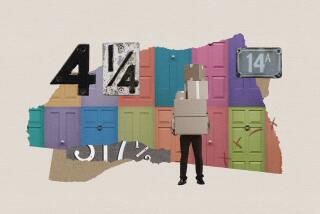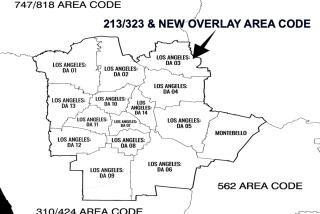Calling a Wrong Number
- Share via
BURBANK — Sometimes the dividing line between the past and the future is hard to see. But Art Aerapetyan has seen the future and he couldn’t be more miserable.
If the proposed 818 telephone area code split goes through as planned in June, one boundary line will be Clybourn Avenue, and Aerapetyan’s Mat Auto Body shop is on the wrong, or east side of that street.
So his phone number, along with 2.8 million others, will be switched into the new 626 area code.
Meanwhile, 20 yards across the street is another auto repair shop that will keep its 818 phone number. “Very unfair,” he says.
“People are going to be afraid to call me because they think 626 is a long-distance call,” Aerapetyan says. “They might think 626 is in San Diego or something.”
He also faces $2,000 in out-of-pocket costs to change phone numbers on his business cards, advertising fliers and receipts. “That’s a lot of money,” he gripes, for a small business that is already struggling.
It’s one reason why Burbank and Glendale have teamed up to try and push the boundary line farther east so both cities can remain in 818. “Otherwise, we’re talking about splitting apart an entire community [the San Fernando Valley] that Burbank has been identified with for decades,” said Terry Stevenson, Burbank’s senior assistant city attorney.
Part of the proposed area code boundary line snakes along the western edge of Burbank. West of that line, the phone numbers remain 818; areas east of it, including Burbank, Glendale, La Canada Flintridge, Pasadena and into the San Gabriel Valley, would become 626.
Adding to this legal tangle is a complaint filed by Monterey Park. The city contends that San Gabriel Valley businesses employ more workers, and their work forces will grow faster in the next 15 years, than those in the San Fernando Valley. Because businesses pay most of the costs of an area code change, Monterey Park says the new area code plans should be flip-flopped, with the San Fernando Valley getting 626.
All this legal squabbling is a fallout from the telecommunications boom and the uncontrollable surge in phone numbers, from fax machines to cellular phones, beepers and pay-at-the-pump gas station credit cards.
In 1947, there were three area codes in California, today there are 13. By 2000 there will be 26 area codes, and the 818 area code is expected to run out of new phone numbers by June 1998.
Administrative Law Judge Philip Weismehl has consolidated the Burbank-Glendale and Monterey Park cases, and he isn’t expected to make his ruling before September. After Weismehl’s decision, the state Public Utilities Commission will make the final ruling on this case, but probably not until October. And the PUC could overturn Weismehl’s decision.
So far in the early legal skirmishes, the Burbank-Glendale team hasn’t fared too well. The attorneys wanted to take Weismehl and PUC members on a driving tour to see why their communities are closely linked geographically with the San Fernando Valley, and they wanted to hold more public hearings. But Weismehl denied both requests.
Helen Mickiewicz, an attorney with the PUC’s Division of Ratepayer Advocates, expects that Weismehl will leave the 818/626 area code boundaries just as they were proposed. Attorneys for Burbank-Glendale and Monterey Park have made a good argument, she says. “But it has to be a compelling argument” to alter current plans, “and they are not.”
One oddity about area code splits is that telephone exchanges often don’t exactly mirror city boundaries. So if the pending 818/626 split goes through, a half a dozen blocks in Burbank will remain in the 818 area code, while the rest of the city turns into 626.
Mickiewicz notes that in recent years many cities have been carved up by area code changes. During the 310-213 area code split, West Hollywood and Beverly Hills--despite many complaints--each ended up with different area codes.
Pacific Bell is in the odd position of defending in court the 818/626 geographic split--as the appointed representative of the telecommunications industry--even though it prefers an “overlay” to handle new area codes.
In an overlay, only new phone numbers would get the 626 area code, while existing customers could keep their 818 numbers. Pac Bell likes overlays because they are cheaper and faster to put in place.
But other phone and cable companies, eager to compete in the local phone market, insist that an overlay would give Pac Bell an unfair edge because most of its customers would keep their 818 numbers, while customers switching to a new phone company would get stuck with a 10-digit local phone number in the 626 area code.
The PUC likes the idea of eventually using overlays, but says the technology is not ready to handle the 818/626 split.
So for those small businesses and homeowners unlucky enough to be on the wrong side of the street, change is coming.
Consider Susan Rubin, who lives on the east side of Clybourn Avenue in a pleasant residential block in Burbank near the Lakeside Country Club. Across the street, her neighbors will probably keep their 818 area code, while Rubin will switch to 626.
“I don’t want to be a NIMBY about this, but I’d rather stay in 818. I just think Glendale and Burbank should be kept in the Valley rather than put in with Monterey Park,” she says.
Rubin has delayed ordering a new phone line in her home for a fax machine until she knows what area code she gets.
And then there’s her confusion about the two cellular phones and one pager that she and her husband have. Depending on whether their cellular phone company routes its calls through a big switching center in Sherman Oaks, or uses a different route, Rubin’s home phone may be put into the 626 area code, but her cellular phones will stay in 818.
One thing Rubin is sure about is that she plans a mass mailing of new phone numbers next year to her aunts and uncles in Canada. “They’re going to be as confused as can be,” she says.
A small businessman trying to work through this chaos is Paul Router, a tax and financial planner who runs Steven Paul & Co. in Burbank. His office is a few steps on the “wrong” side of the area code dividing line. “I think we should stay in 818 so there would not be so much confusion,” he says.
But in the end, Router expects to spend $3,000 to catch up to the area code changes, $2,500 of that for stationary and business forms, and another $500 to change his office number on the ads he buys in church bulletins.
“I’ll probably lose some referrals,” he says. “And some clients will get pissed. They’ll dial 818 and get referred by a recording to another number.”
At least he’s been through all this before. In 1984, his office was in Universal City when the Valley was carved off from the 213 area code and he, along with the rest of the Valley, took on the new 818 area code.
“It will be a major inconvenience,” he says. “There will be a lot of confusion. But we’ll live with it, like the last one in ’84.”
More to Read
Inside the business of entertainment
The Wide Shot brings you news, analysis and insights on everything from streaming wars to production — and what it all means for the future.
You may occasionally receive promotional content from the Los Angeles Times.










